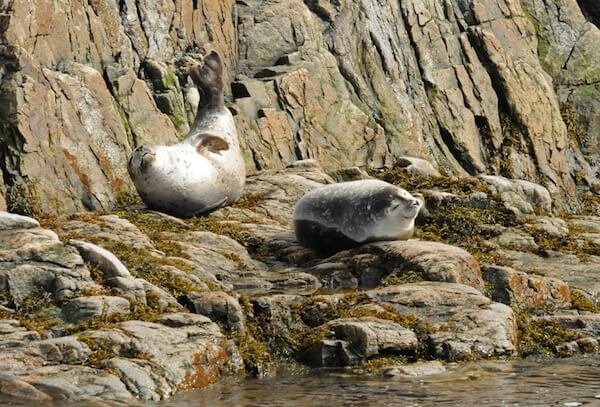This week’s observations revolve around seals! In Franquelin and Tadoussac, just one harp seal and one gray seal are seen, respectively, while in Gaspé, hundreds of gray seals are discovered near Douglastown as they soak up the sun. On the ice floes or dry land, seals give birth, reproduce, rest and moult.
In the course of their lives, seals undergo several moults. In the first months of life, young seals, or pups, will usually moult multiple times and will pass through different stages between their baby fur and their adult coat. In many species, the long white coat of newborns is an excellent insulator – until they manage to build up a decent layer of fat thanks to a brief but highly effective suckling period (article in French) – as well as the ideal camouflage on the ice and snow, where some pups will remain alone for several weeks after they have been weaned. The harbour seal is born with a similar colour pattern as that of the adult. Its first moult often takes place while it is still in its mother’s belly.
After having gone through all the fur colour stages between birth and adulthood, seals continue to moult on an annual basis. Every year at the same time, they lose their entire coat to make way for a new one. During these periods, these marine mammals spend much more time out of the water, as moulting causes a loss of fur and epidermal cells. The process requires a great deal of blood at the body surface for the production of new skin and hair, which causes the animal to leave the water in order to conserve its body heat. Seals will usually spend three to five weeks on land or on the pack ice, during which time they must draw from their fat reserves.
Moulting is a necessary process for renewing the skin and fur. In humans, the replacement of the cells of the epidermis is continuous; dead cells flake off and are replaced by new ones. Whales also moult (article in French), which notably allows them to dislodge organisms that attach themselves to their bodies such as diatoms (algae) and barnacles (crustaceans).
Moulting in harp seals lasts about four weeks beginning in April and, during this period, the animals rarely feed and lose more than 20% of their fat reserves. Then they return to the North where they spend the summer. The harbour seal moults from July to mid-September, at which time its fur deteriorates and becomes yellowish gray. It often shares its haulout sites with the imposing gray seal, which moults between April and June. Lastly, the hooded seal loses its coat in July and August when it is on the ice floes off the coast of Greenland.
The ice field that had extended all around Cap-aux-Os for the past several months began to break up this week thanks to strong winds and the waters came back to life. Observers are hopeful that they will soon be treated to the sight of large spouts. The same goes for Sept-Îles, where the ice has disappeared from the landscape. Our collaborator Jacques Gélineau from INREST reports: “the recent arrival of seabirds such as gulls is a good sign for the imminent arrival of whales.” To be continued!





